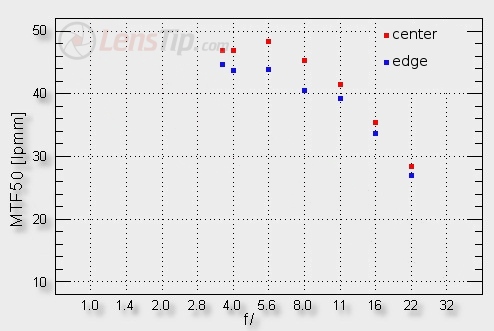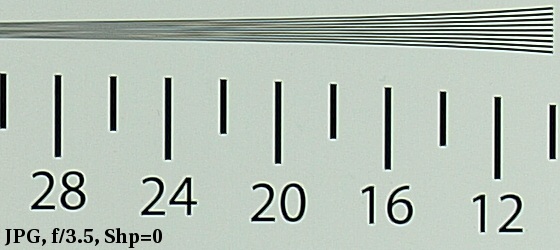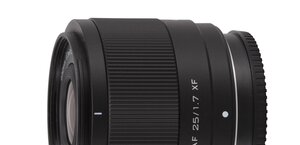Olympus Zuiko Digital 35 mm f/3.5 Macro
4. Image resolution
One more thing is worth adding here. So far, all optics tests have been conducted on APS-C/DX sensors with the focal length multiplier of 1.5-1.6x. As the Olympus E-510 features a 10 megapixels sensor, because of 2x multiplier it is not exactly the same as a 10 megapixel sensor of the Nikon D200, the Sony Alfa 100 or the Samsung GX-10. In the Olympus, the pixels are more densely packed (and we mean here the linear density) than in the Nikon D200 by 23.6% and more densely packed by over 30% than in the Canon 20D. It entails a greater detail rendering capability. Whether that potential is used and to what degree, depends on the construction of the sensor itself, its image quality, the level of noise and all kind of algorithms and operations performed on an image. To sum up we should expect that MTF50 function values, measured on the sensor of the Olympus E-510 should be higher than those reached on the Nikon D200 and even a bit higher than those of the Canon 20D. How higher exactly we are going to explain in a moment.
The graph below presents the MTF 50 function values depending on the apertures; it was measured in the frame centre and on the edge. First noticeable thing is an excellent performance at the maximum relative aperture. To speak bluntly you can say that the Olympus ZD 3.5/35 uses its potential to the full, providing you with photos as sharp as a razor in the whole aperture range available. What’s more, these words are true both for the frame centre and for its edge! A standing ovation!
Please Support UsIf you enjoy our reviews and articles, and you want us to continue our work please, support our website by donating through PayPal. The funds are going to be used for paying our editorial team, renting servers, and equipping our testing studio; only that way we will be able to continue providing you interesting content for free. |
- - - - - - - - - - - - - - - - - - - - - - - - - - - - - - - - - - - - - - - - - - - - - - - -

Can we compare these results with the performance of lenses from other companies? Let’s try. By such apertures as f/16 and f/22 the lenses’ work is limited by diffraction which means that the image quality is not influenced by aberrations of their optics and the only limit is diffraction and the quality of a sensor. By comparing how good quality fixed-focal lenses fare by f/16 and f/22 you can in a sense determine the influence of the sensor itself on your measurements. So far we used a conversion factor between an 8 megapixel Canon’s 20D sensor and, for example, 10 megapixel sensors of the Nikon D200 and the Sony Alfa 100. In the Canon’s case all lenses closed down to f/16 have results near 30 lpmm and for the D200 and the Alfa 100 they reach less than 33 lpmm which indicates that the difference between MTFs is less than 10%; such was also our suggested conversion ratio when directly comparing lenses from various producers tested on different cameras. In the case of fixed-focal devices, tested on the E-510, the level of 35-36 lpmm is reached by f/16. It suggests that, when comparing the results of Olympus lenses with those of Nikkors or Sony instruments you have to decrease their MTFs value by about 7-8%. The maximum result of 48.1 lpmm, reached by the 3.5/35 is an equivalent of more or less 45 lpmm on the D200/Sony Alfa 100 sensors. Such a level is still a great one because MTFs near 45-46 lpmm are got only by the best Nikkor or Sony lenses. When comparing the tested lens results to those obtained on the Canon 20D the conversion ratio must be higher accordingly so here the Olympus lenses’ MTFs have to be decreased by almost 20%. The result of 48.1 lpmm would be an equivalent of 41 lpmm which is once again a splendid result.
It’s worth mentioning here that the conversion ratios, given above, are just approximates and for more than one reason. First of all, we deal here with measurement errors. You can avoid them to a certain extend by averaging the results out but, all in all, only in the case of tests performed on the Canon and the Nikon we have a sufficiently high number of samples available. It is the first Olympus test so, after publishing more of them, with better statistics, we will be able to verify the values given here.
I wrote at length about it but, contrary to appearances, the issue is important. It’s not about any comparison, like, say, between the Olympus ZD 3.5/35 Macro and the Sony 2.8/50 Macro because neither an Olympus user will be able to attach a Sony lens to its reflex camera nor a Sony Alfa 100 user will profit from a Zuiko lens. On the other hand it is interesting how different producers managed to carry out the same tasks. You can hear from several mouths how wonderful Zuiko or Pentax Limited series lenses are. Without comparing them with other systems’ offers, though, we can’t objectively say they are really that brilliant. However, our roughly computed ratio, allowing us the comparison of the cheap Zuiko 3.5/35 to other devices, shows that the good opinions concerning Olympus optics were not exaggerated. We know it because we were able to compare appropriate lenses in an objective way and not because somebody on a forum simply expressed his subjective opinion; perhaps this person photographs using just one system and has no idea what other systems have to offer. That’s not all. Such a comparison has a greater meaning when we want to deal with independent producers. For example Sigma has started to design a lot of its optical devices for the 4:3 format. As long as these lenses are not tested on the E-510 or its professional brother you can try to transpose the resolution values, reached on the Canon 20D, and compute their would-be results when joined with the Olympus. Of course these approximations can’t substitute for direct measurements but it is better than nothing – after all, there are few optics tests performed on Olympus cameras published on the Internet.
 |






